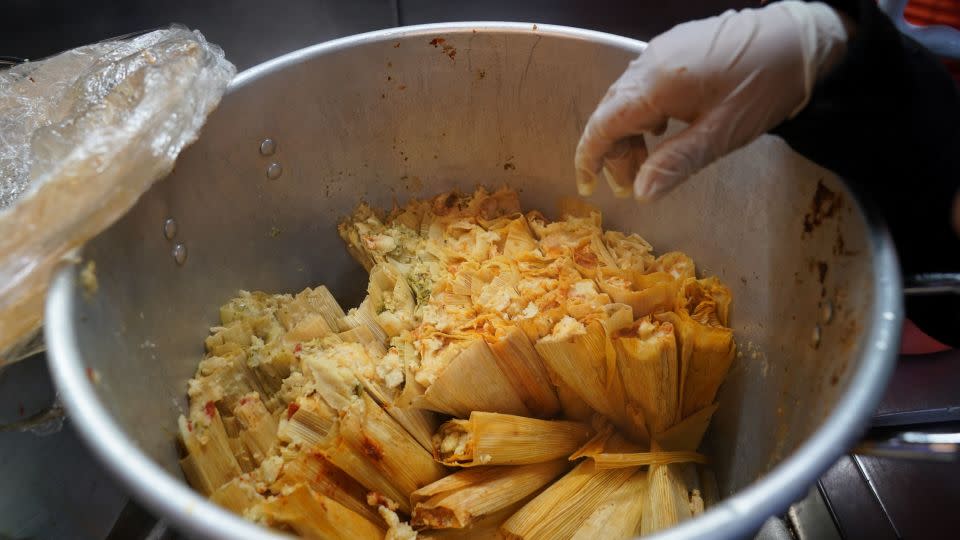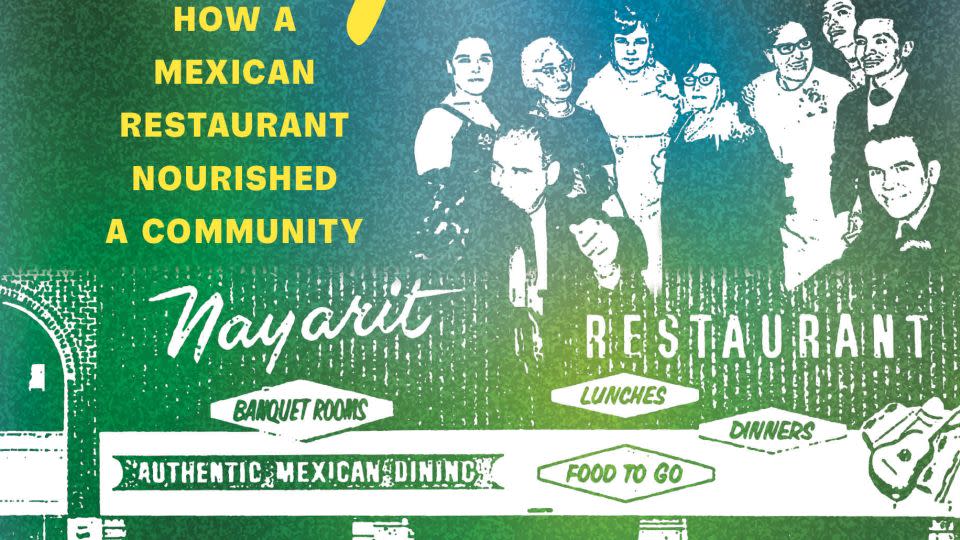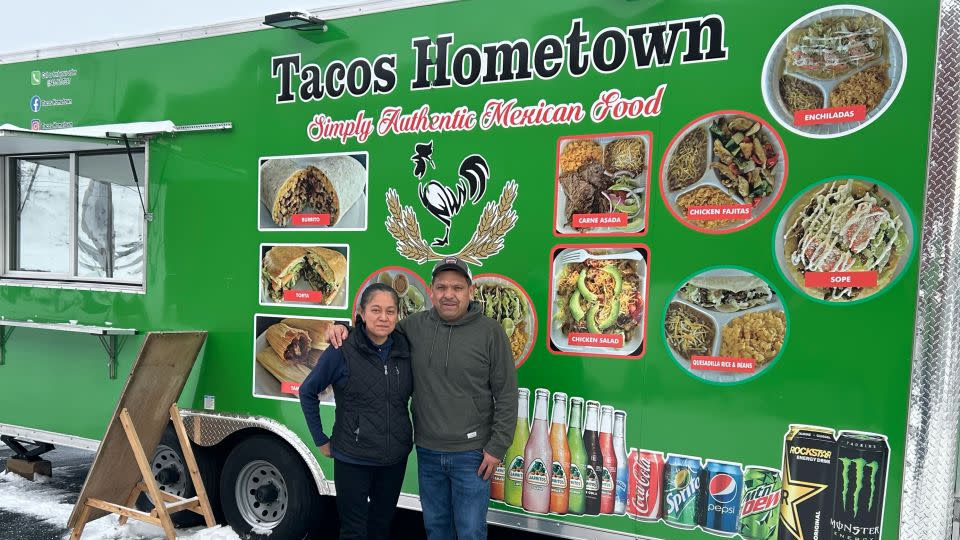There isn’t a taco truck on every corner. But there’s a Mexican restaurant in nearly every US county
As falling snow blankets the ground around his bright green taco truck in rural eastern Oregon, Amado Juarez puts the finishing touches on an order.
It’s a labor of love for Juarez, 53, who takes pride in the food he and his wife prepare and serve.
“We make everything personally,” he told CNN in a recent Zoom interview. “We give it our own seasoning.”
Years ago, Morrow County, Oregon, would have been a surprising place to find the carne asada, enchiladas and tacos Juarez is known for. But his family’s food truck, Tacos Hometown, has been operating in this rural community some 1,100 miles from the US-Mexico border for more than a decade, serving up “simply authentic Mexican food” to a largely American clientele.
A recent report from the Pew Research Center lists Morrow County as one of the places with the highest concentration of Mexican eateries in the US. According to Pew’s analysis of data from SafeGraph, more than a third of restaurants in the county serve Mexican food. The other counties listed in that ranking are all located in border states.
It’s one telling example of how Mexican food has spread throughout the United States.
Roughly 1 in 10 restaurants in the US serve Mexican food, according to Pew’s analysis of SafeGraph and Yelp data, with Mexican restaurants found in a large majority of US counties.
“Mexican food exists exactly where you would expect it to, but also pretty much anywhere else you might care to look in the United States that has any significant number of people in it,” says Aaron Smith, Pew’s director of data labs research. “In the middle of Oregon somewhere, out between the Pacific Ocean and the Rockies, there’s this little moderately sized community where over a third of the restaurants are serving Mexican food, which is kind of fascinating.”
99% of the US population now lives near a Mexican restaurant. That wasn’t always the case
There’s not a taco truck on every corner, as a Trump supporter once warned could happen in the runup to the 2016 election – spurring backlash and mockery on social media, and even inspiring a campaign to use taco trucks to help with voter registration.
But Mexican cuisine in the US is flourishing near the border, and also thousands of miles away. Tacos and tamales can be found in food trucks and five-star restaurants, in big cities and small towns.

Decades ago, the landscape was dramatically different. As food historian Jeffrey Pilcher notes in “Planet Taco: A Global History of Mexican Food,” in the middle of the 20th century, Mexican restaurants outside the Southwest were rare in the US.
Pilcher points to a number of factors that contributed to Mexican food’s increasing prevalence, including a “renaissance for family restaurants serving Mexican regional cooking throughout the United States” as large numbers of migrant workers from Latin America came to the US starting in the 1980s.
Now, as Pew’s analysis shows, Mexican food can be found almost everywhere in the US.
According to the report, 99% of the US population lives in a county with at least one Mexican restaurant.
This historian sees a deeper story behind the numbers — and a contradiction
Historian Natalia Molina says behind each data point there are even richer stories to tell — and important questions to ask.
“If we want to understand immigration, if we want to understand Latino culture, if we want to understand our neighborhoods, the way that our cities and counties and states are changing, food and restaurants are a central part of that,” Molina says. And numbers, she says, only tell part of the story.
Yes, foodies across the US now scour sites like Eater to find the trendiest tacos.
But, Molina notes, “at the same time we can’t pass immigration reform, at the same time every time you turn on the news there’s a new crisis at the border.
“It’s begging the question — can we cherish Mexican cuisine without embracing Mexicans?”
For Molina, a distinguished professor of American studies and ethnicity at the University of Southern California, the question isn’t simply academic. It’s closely intertwined with her family’s personal history.

Molina’s grandmother once ran a beloved Mexican restaurant in Los Angeles, and she documents its history — and the vital importance of other restaurants like it — in her book “A Place at the Nayarit: How a Mexican Restaurant Nourished a Community.”
Her mother sold the restaurant lease when Molina was a child. Its new owners closed it in 2001. Later that year, the building became a nightclub.
About 37 million people in the United States trace their ancestry to Mexico, according to Pew, and Mexicans represent the largest group of immigrants living in the US. While there are many Mexican restaurants in the US — not to mention restaurants serving other types of cuisine where Mexican immigrants work — Molina says a key detail can get lost when focusing on overall numbers.
Gentrification is changing neighborhoods that once were epicenters of working-class Latino life, Molina says, and beloved restaurants where people could find community are closing.
“When that gets replaced by someone selling your matcha latte and your avocado toast, it’s not going to draw the immigrant generation or the working-class immigrants,” she says.
Meanwhile, Molina hopes that in addition to embracing Mexican cuisine, consumers will think more about how that food is making it to their table.
“That’s brought to you by a chain fueled by immigrants,” she says.

Some Americans got their first taste of Mexican food from this taco truck
At first, Amado and Elia Juarez weren’t sure how the residents of Morrow County would respond to their taco truck.
“There are very few Mexicans here. When we moved to Ione, Oregon, in 2002, we were the first Mexicans,” Elia recalls.
So when they opened up their taco truck in 2013, they went with a name they hoped would help them connect with customers. Amado’s former boss at the dairy farm where he’d worked for decades offered a suggestion that stuck.
While many taco trucks invoke the names of their owners or Mexican locales, “Tacos Hometown” aimed to appeal both to immigrant agricultural workers in the area and the larger community they hoped to serve.
But they knew their Mexican heritage would be a key ingredient.
They painted the taco truck green as a tribute to Amado’s late father, whose home in Mexico’s Guerrero state was the same bright color.
And they didn’t change the foods to appeal to an American palate.
It wasn’t long before their business was thriving, Amado recalls.
“They really love the spicy salsa,” Elia says.

Getting ingredients to make the fresh food that’s become their trademark isn’t easy. The closest city is a 50-minute drive, and often they’ll drive an hour and a half to get products in bulk. But they say going the extra miles — literally — is worth it to keep customers happy.
The dairy industry has brought more Mexicans to the area since they first arrived, but the Juarez family says Mexican eateries are still relatively rare. Other taco trucks and restaurants they know of are about an hour away, on the other side of the county or outside its limits.
Juarez says most of his taco truck’s customers are American. Opening the business, he says, has helped his family feel closer to their community.
He marvels at the generous tips American customers leave. On his phone he keeps a photo of the day when students in a local high school Spanish class showed up and serenaded him. And he’s even visited a preschool to give a presentation on Mexican food.
“I see them as my future customers,” he laughs.
And wherever those toddlers end up traveling in the years to come, there will be plenty of restaurant options to choose from for the kids from rural Oregon who learned to love tacos in their hometown.
For more CNN news and newsletters create an account at CNN.com

